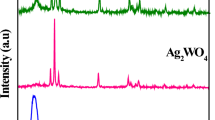Abstract
Reactive oxygen species (ROS) can be produced by the interactions between sunlight and light-absorbing substances in aqueous environments, and these ROS are capable of destroying various organic pollutants in wastewater. In this study, the photocatalytic degradation of ammonia in petrochemical wastewater was investigated by solar light photocatalysis. We used graphene oxide modified Ag2Se nanoparticles to enhance the activity of photochemically generated oxygen (PGO) species. There was a catastrophic decrease in the surface area and pore volume of the Ag2Se-graphene oxide (Ag2Se-G) samples because of the deposition of Ag2Se. The generation of ROS was detected by the oxidation of 1,5- diphenyl carbazide (DPCI) to 1,5-diphenyl carbazone (DPCO). It was revealed that the photocurrent density and PGO effect increased with the graphene oxide modified. The experimental results indicate that this heterogeneous catalyst achieved a degradation of 88.43% under visiblelight irradiation. The NH3 degradation product was N2 and neither NO2− nor NO3− were detected.

Similar content being viewed by others
References
A. A. Halim, H. A. Aziz, M. A. Megat, K. Shah, and M. Nordin, J. Hazard. Mater. 175, 960 (2010).
D. E. Meeroff, F. Bloetscher, D. V. Reddy, F. Gasnier, S. Jain, A. McBarnette, and H. Hamaguchi, J. Hazard. Mater. 209-210, 299 (2012).
M. Altomare, G. L. Chiarello, A. Costa, M. Guarino, and E. Selli, Chem. Eng. J. 191, 394 (2012).
H. Liu, X. N. Dong, X. C. Wang, C. C. Sun, J. Q. Li, and Z. F. Zhu, Chem. Eng. J. 230, 279 (2013).
Z. D. Meng, M. M. Peng, L. Zhu, and W. C. Oh, Appl. Catal. B Environ. 113-114, 141 (2012).
J. F. W. Mosselmans, R. A. D. Pattrick, G. van der Laan, J. M. Charnock, D. J. Vaughan, C. M. B. Henderson, and C. D. Garner, Phys. Chem. Minerals 22, 311 (1995).
N. Nakashima, T. Ishii, M. Shirakusa, T. Nakanishi, H. Murakami, and T. Sagara, Chem. Eur. J. 7, 1766 (2001).
J. J. Zhao, B. T. Jiang, S. Y. Zhang, H. L. Niu, B. K. Jin, and Y. P. Tian, Sci. China Ser. B Chem. 52, 2213 (2009).
H. M. Pathan and C. D. Lokhande, Bull. Mater. Sci. 27, 85 (2004).
V. Buschmann, G. V. Tendeloo, P. H. Monnoyer, and J. B. Nagy, Langmuir 14, 1528 (1998).
J. Wang, Y. W. Guo, B. Liu, X. D. Jin, L. J. Liu, R. Xu, Y. M. Kong, and B. X. Wang, Ultrason. Sonochem. 18, 177 (2011).
X. W. Zhang, M. H. Zhou, and L. C. Lei, Carbon 43, 1700 (2005).
A. Tubtimtae, M. W. Lee, and G. J. Wang, J. Pow. Sour. 196, 6603 (2011).
S. Sharma, S. Singh, A. K. Ganguli, and V. Shanmugam, Carbon 115, 781 (2017).
F. G. Xu, S. Xie, R. T. Cao, Y. N. Feng, C. J. Ren, and L. Wang, Sens. Actuat._B Chem. 243, 609 (2017).
Z. D. Meng, T. Ghosh, L. Zhu, J. G. Choi, C. Y. Park, and W. C. Oh, J. Mater. Chem. 22, 16127 (2012).
Y. Cui, G. Chen, J. Ren, M. Shao, Y. Xie, and Y. Qian, J. Solid State Chem. 172, 17 (2003).
K. A. Zeynali and F. Mollarasouli, Sens. Actuat. B Chem. 237, 387 (2016).
C. Zhu, S. Guo, Y. Fang, and S. Dong, ACS Nano 4, 2429 (2010).
K. N. Kudin, B. Ozbas, H. C. Schniep, R. K. Prud'homme, I. A. Aksay, and R. Car, Nano Lett. 8, 36 (2008).
O. Akhavan and E. Ghaderi, Carbon 50, 1853 (2012).
Y. Zhou, B. Xiao, S. Q. Liu, Z. D. Meng, Z. G. Chen, C. Y. Zou, C. B. Liu, F. Chen, and X. Zhou, Chem. Eng. J. 283, 266 (2016).
M. D. Donohue and G. L. Aranovich, Fluid Phase Equilib. 158-160, 557 (1999).
H. I. Kim, G. H. Moon, D. M. Satoca, Y. Park, and W. Y. Choi, J. Phys. Chem. C 116, 1535 (2012).
Z. D. Meng, L. Zhu, J. G. Choi, C. Y. Park, and W. C. Oh, Nanoscale Res. Lett. 6, 459 (2011).
R. Azumi, K. Kakiuchi, and M. Matsumoto, Bull. Chem. Soc. Jpn. 76, 1561 (2003).
J. Wang, Y. W. Guo, J. Q. Gao, X. D. Jin, Z. Q. Wang, B. X. Wang, K. Li, and Y. Li, Ultrason. Sonochem. 18, 1028 (2011).
D. Ma, M. Zhang, G. Xi, J. Zhang, and Y. Qian, Inorg. Chem. 45, 4845 (2006).
H. Q. Cao, Y. J. Xiao, Y. X. Lu, J. F. Yin, B. J. Li, S. S. Wu, and X. M. Wu, Nano. Res. 3, 863 (2010).
D. L. Miles and C. Espejo, Analyst 102, 104 (1977).
X. Zhu, S. R. Castleberry, M. A. Nanny, and E. C. Butler, Environ. Sci. Technol. 39, 3784 (2005).
Author information
Authors and Affiliations
Corresponding authors
Rights and permissions
About this article
Cite this article
Meng, ZD., Zhao, W. & Kim, S. Properties of photocatalytically generated oxygen species produced by Ag2Se-graphene oxide heterojunction and its application for the visible-light degradation of ammonia. Electron. Mater. Lett. 13, 518–526 (2017). https://doi.org/10.1007/s13391-017-6391-3
Received:
Accepted:
Published:
Issue Date:
DOI: https://doi.org/10.1007/s13391-017-6391-3




